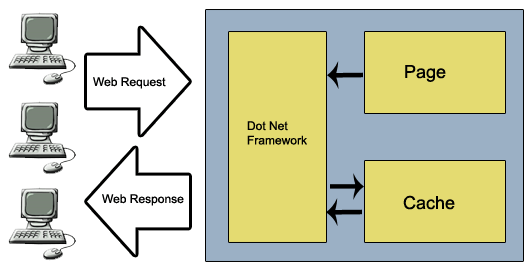ASP.NET Cache
原文地址:http://www.codeproject.com/KB/aspnet/AspDotNetCache.aspx

缓存是在内存中存储很耗时创建的数据的一项技术,也是ASP.NET一个重要特性。例如,你可以缓存那些耗时的复杂查询出来的数据,之后的请求不必再从数据库中取数,直接从缓存中取。通过缓存,可以大大提高应该程序的性能。
主要有两种缓存类型:
1.输出缓存
2.数据缓存
1. Output Caching(输出缓存)
使用输出缓存,可以缓存页面最终的生成的HTML。当同一个页面再次请求时,缓存页起作用。ASP.NET不再执行页面的生命周期和相关代码。输出缓存的语法:
Duration 属性设置页面将缓存60秒,在所有用户的请求中的第一次请求,ASP.NET执行页面代码,把生最终生成的HTML结果呈现给用户,并在缓存保存。如果服务器在60秒内再次接到同一个页面的请求,ASP.NET自动发送缓存中备份页面给用户。如果服务器在缓存过期后接到一个请求,ASP.NE执行页面代码并为下一个60秒创建一个新的HTML缓存。
<%@ Page Language="C#" MasterPageFile="~/MasterPage.master" AutoEventWireup="true" CodeFile="OutputCachingTest.aspx.cs" Inherits="OutputCachingTest" Title="Untitled Page" %> <%@ OutputCache Duration="20" VaryByParam="None" %> <asp:Content ID="Content1" ContentPlaceHolderID="ContentPlaceHolder1" runat="Server"> <div class="title">Output Cache</div> Date: <asp:Label ID="lblDate" runat="server" Text="" /> Time: <asp:Label ID="lblTime" runat="server" Text="" /> </asp:Content>
protected void Page_Load(object sender, EventArgs e) { lblDate.Text = DateTime.Now.ToShortDateString(); lblTime.Text = DateTime.Now.ToLongTimeString(); }
在本例中, 页面将被缓存20秒。
Cache by Query String (通过查询字符串缓存)
在实际应用中,动态页面是根据参数改变页面内容的。如果你的页面是通过查询字符串来接收信息的,你也可以很容易的根据查询字符串来缓存页面的不同拷贝。VarByParam=”None” 告诉ASP.NET只存储页面的一份拷贝。VarByParam=”*”告诉ASP.NET根据不同的查询字符串存储不同的页面拷贝。
2
3 < div align = " right " >
4 < a href = " OutputCachingTest2.aspx " > No Query String </ a > |
5 < a href = " OutputCachingTest2.aspx?id=1 " > ID 1 </ a > |
6 < a href = " OutputCachingTest2.aspx?id=2 " > ID 2 </ a > |
7 < a href = " OutputCachingTest2.aspx?id=3 " > ID 3 </ a > |
8 < a href = " OutputCachingTest2.aspx?id=3&langid=1 " > ID 3 </ a >
9 </ div >
在同一个页面中,通过传递不同查询字符串ID值,ASP.NET针对每一个ID值存储一份拷贝,该技术在这种情况下利用的非常好,但是也存在一些问题。如果页面接收很广泛的查询字符串,那么,ASP.Net针对每一个查询字符串参数缓存一份拷贝,并且潜在的降低了重用性。这种情况下,你可以在VarByParam属性中指定几个比较重要的查询参数。
如上所设置,ASP.Net根据不同的“id” 或者 “langid”查询字符串值缓存不同的版本
Custom Caching(自定义缓存)
你也可以创建自定义页面缓存处理过程。ASP.NET提供了一种很便捷的方式来创建自定义缓存,通过给VarByCustom属性指定自定义的缓存类型。
你需要创建一个方法,该方法生成一个自定义缓存字符串。语法如下:
2 {
3 if (custom == " browser " )
4 {
5 return context.Request.Browser.Browser +
6 context.Request.Browser.MajorVersion;
7 }
8 else
9 {
10 return base .GetVaryByCustomString(context, custom);
11 }
12 }
该方法必须写在global.asax文件中,返回一个字符串值。ASP.Net用这个值来实现缓存。如果不同的请求方法返回相同的字符串值,ASP.net重用缓存页面除非产生了一个新的缓存版本。在上面例子中,GetVaryByCustomString()创建了一个基于浏览器名称的缓存字符串。ASP.Net将根据不同的浏览器请求创建不同的缓存版本。
Control Cache(控件缓存)
上面的缓存技术,能让你很容易的缓存整个页面。但是如果你想缓存指定的控件内容,你可以通过VaryByControl属性来缓存一个控件
在.aspx页面上添加上面代码,ASP.net将缓存 MyControl_1控件20秒,这样ASP.net创建一个“MyControl_1”缓存版本,如果缓存没有过期,ASP.net重用该缓存版本,除非控件代码重新执行过。如果你想创建一个依赖于控件某些属性的控件缓存,ASP.net同样很方便,只需在*.ascx控件页上添加OutPutCache指令。
2 CodeFile = " MyControl.ascx.cs " Inherits = " Controls_MyControl " %>
3 <% @ OutputCache Duration = " 20 " VaryByControl = " EmployeeID " %>
4 ......
5 ......
VaryByControl=”EmployeeID” 告诉ASP.net根据控件属性EmployeeID不同值创建不同的控件缓存版本。
在.ascx.cs 文件中添加属性”EmplyeeID“,用于ASP.net创建缓存
2 public int EmployeeID
3 {
4 get { return _employeeID; }
5 set { _employeeID = value; }
6 }
7
8 protected void Page_Load( object sender, EventArgs e)
9 {
10 lblDate.Text = DateTime.Now.ToShortDateString();
11 lblTime.Text = DateTime.Now.ToLongTimeString();
12
13 lblEmployeeID.Text = EmployeeID.ToString();
14
15 }
在页面上添加控件并设置”EmployeeID“
2 < asp:Content ID = " Content1 " ContentPlaceHolderID = " ContentPlaceHolder1 " runat = " Server " >
3 < div align = " center " >
4 < uc1:MyControl ID = " MyControl1 " runat = " server " EmployeeID = " 1 " ></ uc1:MyControl >
5 </ div >
6 </ asp:Content >
Cache Profile(缓存配置文件)
ASP.net在web.config文件中定义缓存设置也是相当的方便。假如你在页面中嵌入缓存设置,并且想从20秒改为30秒,然后你必须在所有页面中更改duration值。最好的方式就是在web.config中设置缓存,你可以非常容易管理你的缓存设置。
2 < caching >
3 < outputCacheSettings >
4 < outputCacheProfiles >
5 < add name = " ProductItemCacheProfile " duration = " 60 " />
6 </ outputCacheProfiles >
7 </ outputCacheSettings >
8 </ caching >
9 </ system.web >
现在你只需要在页面属性中添加CacheProfile=”ProfileName”就可以了。
数据缓存(Date Cache)
ASP.net也提供了灵活的数据缓存。你可以把一些耗资源的项添加到对象缓存集合中。Cache是一个键值对集合,添加项到缓存集合中只需要指定一个新的Key名称。
该技术不支持缓存对象的控制。Cache.Insert()提供了5版本的方法重载,通过使用Insert方法,你可以设置缓存的过期策略、优先级、依赖项等。
2 Cache.Insert( " Date1 " , date1, null , DateTime.Now.AddSeconds( 20 ), TimeSpan.Zero);
Asp.net 允许设置绝对的或者相对的过期策略,但每次只能使用一个。
Cache dependency(缓存依赖项)
同样你也可以在ASP.net中设置缓存依赖项,缓存依赖项允许一个缓存项依赖于另一项资源,但依赖资源改变时,缓存项将自动移除。CacheDependency类用于创建依赖项。这个类有多个构造函数。你可以创建依赖于文件或者文件夹。如果文件或者文件夹改变,缓存将过期。你也可以创建依赖于其它缓存项的依赖项。
2
3 string [] cacheKeys = { " Date1 " };
4 CacheDependency cacheDepn = new CacheDependency( null , cacheKeys);
5 Cache.Insert( " Date2 " , date2, cacheDepn);
在上例中“Date2“缓存对项依赖于”Date1“缓存项。当”Date1“缓存对象过期时,”Date2"缓存项将自动过期。在 CacheDependency(null, cacheKeys)构造函数中,第一个参数为“null",是因为我们不想创建依赖于文件或者文件夹的缓存。我们只需要传递缓存项的Keys列表,因为我们只想创建依赖于缓存项的依赖项。
Callback Method and Cache Priority(回调函数和缓存优先级)
ASP.net也允许你编写一个回调函数,但缓存项从缓存中移除时,该方法将被触发。也可以设置缓存项的优先级。
1 protected void Page_Load(object sender, EventArgs e)
3 DateTime ? date1 = (DateTime ? )Cache[ " Date1 " ];
4 if ( ! date1.HasValue) // date1 == null
5 {
6 date1 = DateTime.Now;
7 Cache.Insert( " Date1 " , date1, null , DateTime.Now.AddSeconds( 20 ), TimeSpan.Zero,
8 CacheItemPriority.Default,
9 new CacheItemRemovedCallback(CachedItemRemoveCallBack));
10 }
11
12 DateTime ? date2 = (DateTime ? )Cache[ " Date2 " ];
13 if ( ! date2.HasValue) // date2 == null
14 {
15 date2 = DateTime.Now;
16 Cache.Insert( " Date2 " , date2, null , DateTime.Now.AddSeconds( 40 ), TimeSpan.Zero,
17 CacheItemPriority.Default,
18 new CacheItemRemovedCallback(CachedItemRemoveCallBack));
19 }
20
21 // Set values in labels
22 lblDate.Text = date1.Value.ToShortDateString();
23 lblTime.Text = date1.Value.ToLongTimeString();
24
25 lblDate1.Text = date2.Value.ToShortDateString();
26 lblTime1.Text = date2.Value.ToLongTimeString();
27
28 }
29
30 private void CachedItemRemoveCallBack( string key, object value,
31 CacheItemRemovedReason reason)
32 {
33 if (key == " Date1 " || key == " Date2 " )
34 {
35 Cache.Remove( " Date1 " );
36 Cache.Remove( " Date2 " );
37 }
38 }
如上例所示,我创建了”Date1"和“Date2"缓存。"Date1"20秒后过期,”Date2"40秒,但是你注意到他们同时过期。原因是因为我们注册了一个移除缓存的回调函数。当'Date1"或"Date2"过期时,将调用CachedItemRemoveCallBack方法。在这个方法中,我移除了这两个缓存项。
Asp.net也提供了缓存项的更新回调函数。CacheItemUpdateCallback代理事件就是为这个而设计的。